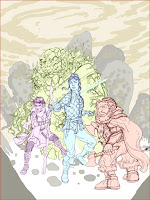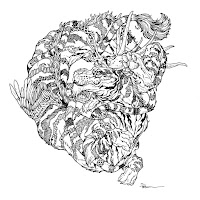Or––that was the idea. In fact, they are a re-design of an old drawing I 'unearthed' when scanning pencil drawings for my Patreon.
A few months ago I shared a revamp of the Skullduggers from the same unmade gaming project.
Back in the earliest of the 2000's, I was toying with the idea of creating a table-top game (like Warhammer) with simpler rules for movement, army creation, etc. While struggling to design those elegant game mechanics (which never materialized) I only ever drew a few of the types of creatures to populate the game with.
To the right is that old drawing of a single Vineling (I envisioned these were the soldiers that could respawn.)
I started the new version digitally keeping the basic forms and ideas, but making them as well as the pose more interesting. I did end up penciling the vine arms, legs and seed-pod staff traditionally on a lightpad overtop of a printout of the digital sketch.
I wanted the arms to be more vine-like and to loose the grill/scarf (I think the original was inspired by the Black Wizard in Final Fantasy Tactics––a game I never played, but always liked the look of that character.)
This piece was a texture mess––and no good way to make it all make sense in black and white without adding shadows I didn't want in the final color...so I just did my best to control the density.
The original inked artwork is avilable for sale in my online store: https://mouseguard.bigcartel.com/product/vineling-original-art
The color choices seemed obvious to me looking at the original and so I used similar colors when doing the digital sketch.
I also added a color hold (where I want the black lineart to be a color other than black) to the overall linework and a special glow around the eyes.


































